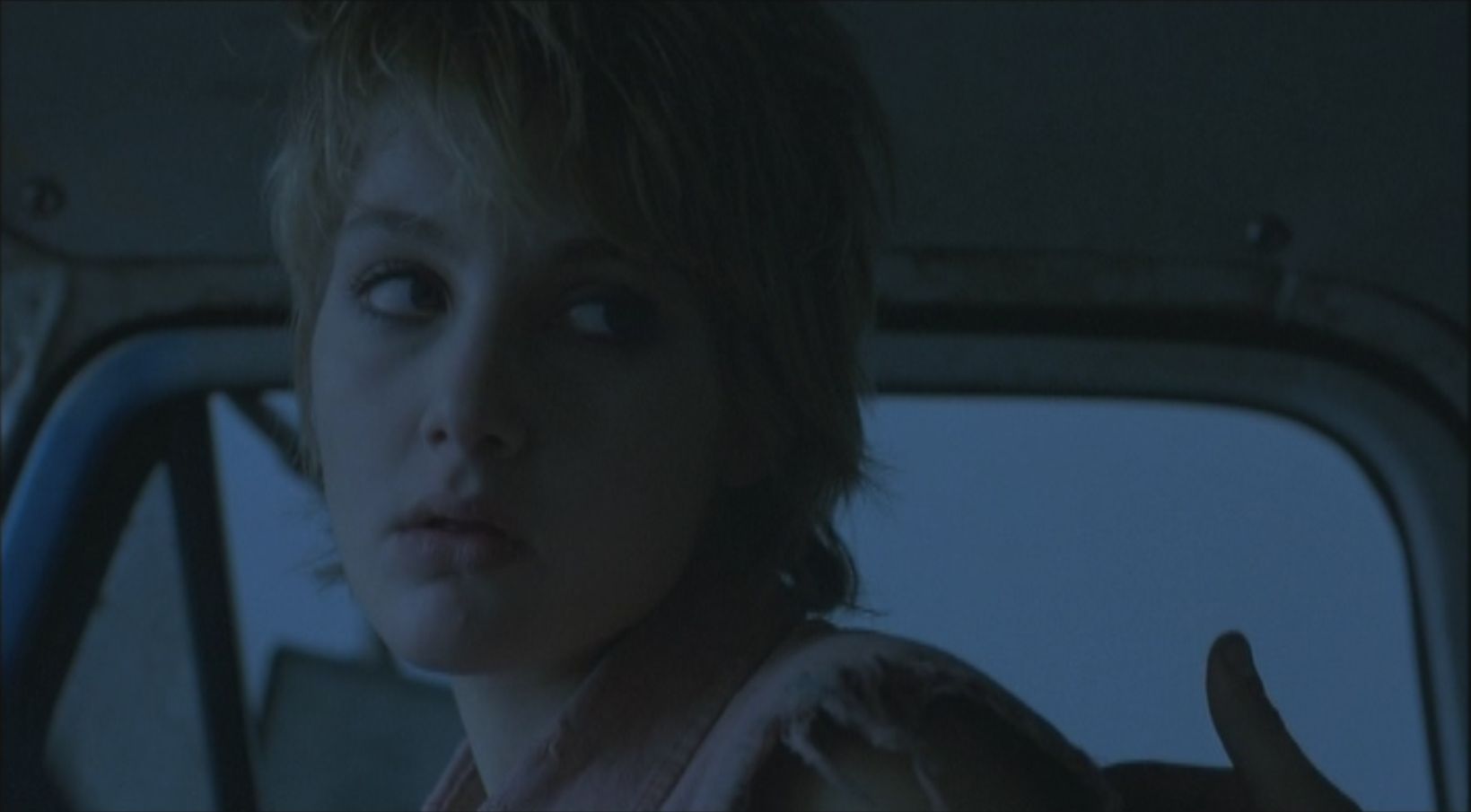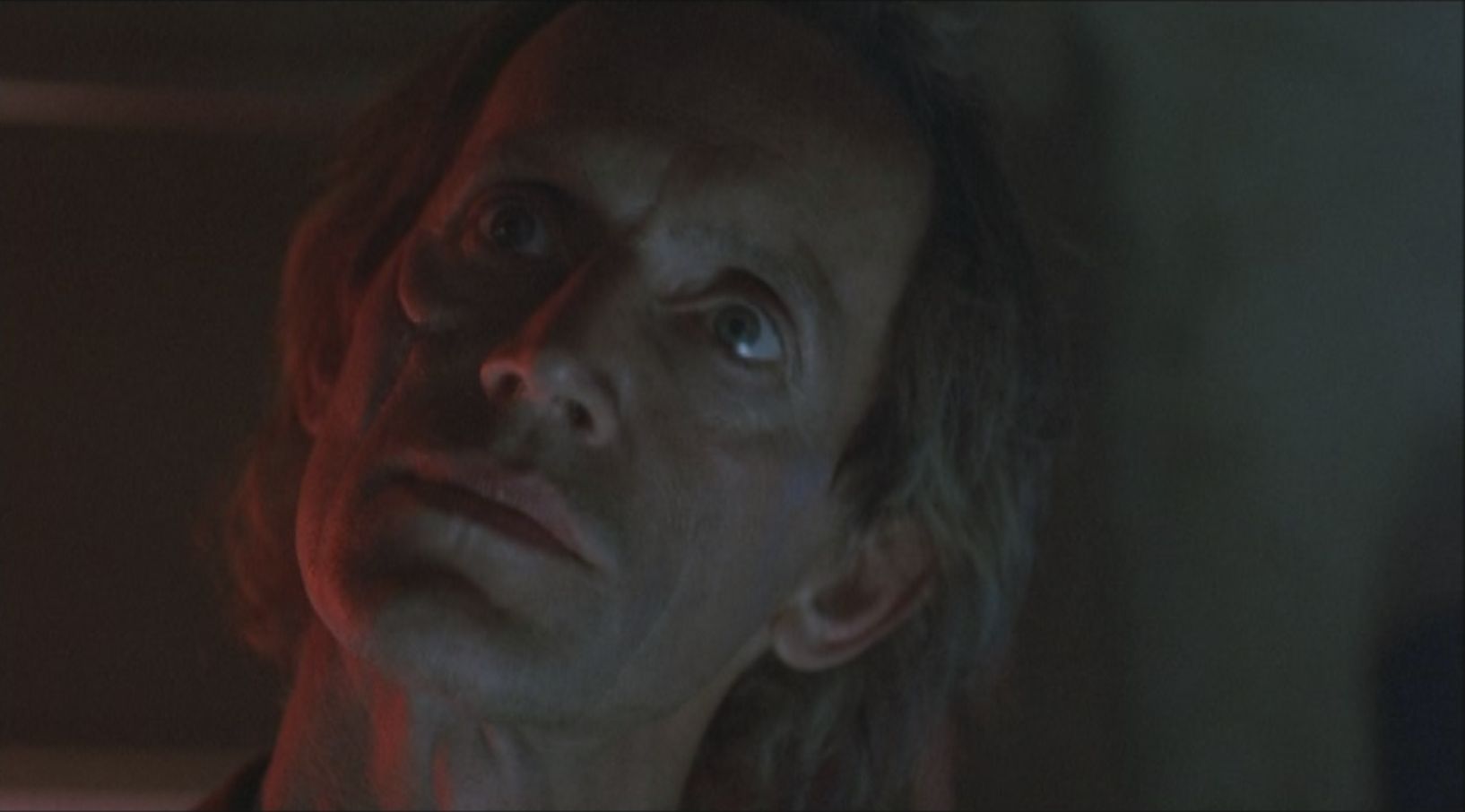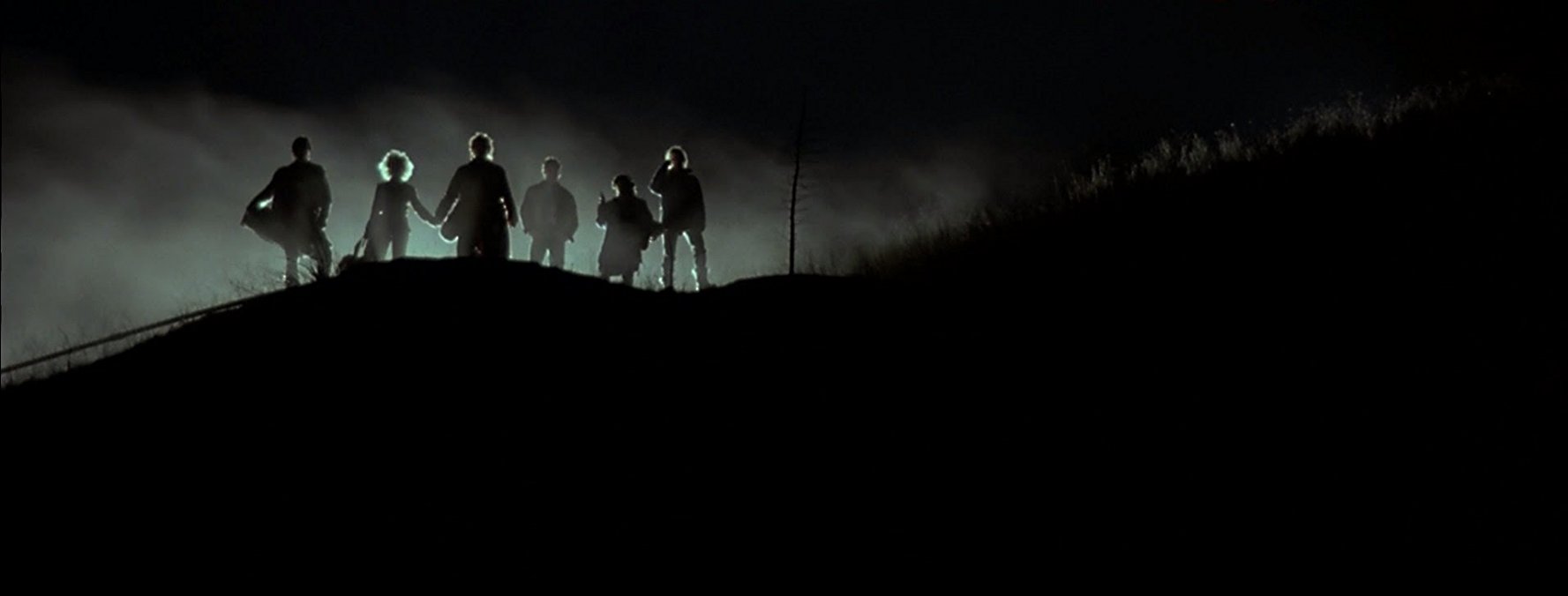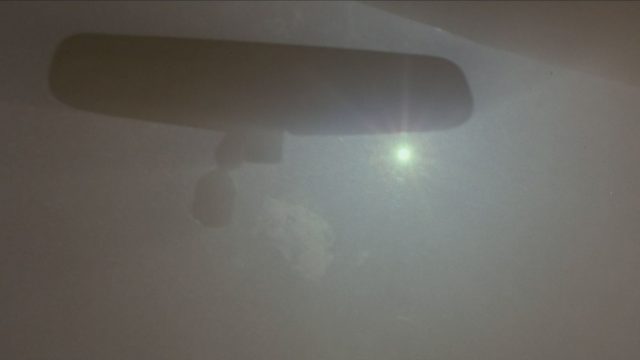What a lovely way to burn. . .
As first films of great directors go, The Loveless is somewhere between Fear and Desire and Killer’s Kiss, neither as incompetent as the former or as intriguing as the latter; Near Dark, though, is undoubtedly Kathryn Bigelow’s (fuck yeah,) The Killing, a tight genre work that establishes the director’s place in the canon, something so assured it’s hard to believe it’s her second film, and it may be her best. Less a vampire movie then a road movie that draws just as much from vampirism as it needs, Near Dark pulls off some stunning sexual imagery, a surprising emotional charge, and at least two great setpieces all done in a relentless pace, over and done in the classic B-movie timeslot of about 90 minutes, still her shortest film since The Loveless.
Near Dark starts getting good with her co-writer, Eric Red, one of her career’s best collaborators. Red had a real talent for stripped-down horror films, works that weren’t constrained by realism but hit the necessary psychological beats of horror and/or action: The Hitcher, Cohen and Tate, Body Parts. He worked on the kind of films that got ignored in theaters but lived a good second life in the exploding video market of the 1980s and 90s–certainly that’s how I became aware of him. Bigelow and Red both have a complete commitment to genre (the one good thing to carry over from The Loveless) and now she had the skill to make it work, creating something on the level of John Carpenter’s Escape from New York, maybe even The Thing.
NEAR SPOILERS
Bigelow hits the ground running, even faster than Carpenter–the credits have just finished when Caleb (Adrian Pasdar) sees Mae (Jenny Wright) and the plot starts–but you’d never mistake Near Dark for a Carpenter film. He orients everything to serve the action; each scene is about a task to be accomplished, nothing more or less, workmanlike in the best sense. Bigelow discovers a sensuality here that continues through her whole career, almost a painter’s quality of touch rather than vision, lingering over images and bodies and especially skin for as long as she dares. (It’s a big step up from The Loveless where the sensuality was a matter of “point the camera at Willem Dafoe and hope for the best”; to be fair, that’s not nothing.) On a strictly technical level, if this was a Carpenter film it would be six minutes shorter: Bigelow is a master of slow motion and Carpenter almost never uses it.
That’s all apparent in the first ten minutes here, which tell us so much about where the story is going–even Mae’s first two words (“Bite?” “Dying?”) are wonderfully overt B-movie foreshadowing. A long sequence where a man picks up a woman and drives her around an isolated landscape at night is something that’s almost always played as a threat to the woman (Zodiac has an exquisitely tense example of this) but here, Caleb only thinks he’s in control: at all moments, Mae dominates him. Bigelow and Wright establish her off-centeredness (what is she hearing in the night?), that she’s stronger than Caleb, that she spooks horses, that she’s not completely in control of her appetites, and that the one thing she fears is the dawn. The sequence opens with slow motion (the reveal of Mae) and finishes with it, in the long kiss that Caleb extorts from her.
Bigelow lingers on this moment more than I’ve ever seen in a vampire movie, or maybe any other movie, and gives it more care too, from Wright’s first look (an equal mix of fear and hunger, both intense) right down to biting him. Bigelow choreographs Wright and Pasdar (and the breathing on the soundtrack, and Tangerine Dream’s music) with all the attention she gives to the action scenes later. She creates an arc to the scene of Mae’s rising hunger (and that it’s slipping out of her control) and she also revels in the pleasure of looking at these young bodies, and lets us do it too.
 What starts in this scene continues through the end of the movie and straight past that into the rest of her career: this open and intense eroticism, based on an appreciation of bodies and their sensations. One year before, Michael Mann did something like this with Joan Allen, Tom Noonan, and a tiger in Manhunter, but Bigelow gives us a whole movie’s worth of it. In what could be Near Dark’s most iconic moment (although there’s at least one strong competitor), she shows gigantic oil pumps metaphorically sucking blood from the ground, and then cuts to the real thing happening in the same shot, the kind of fake-right-and-move-right edit she used in The Loveless, but so much more powerful here; I could feel the pull of the blood in my own body. Brian dePalma said that films are about what people see, but Bigelow’s goal always seems to be films that make us feel, on a sensual more than emotional plane. She doesn’t even need nudity to do it.
What starts in this scene continues through the end of the movie and straight past that into the rest of her career: this open and intense eroticism, based on an appreciation of bodies and their sensations. One year before, Michael Mann did something like this with Joan Allen, Tom Noonan, and a tiger in Manhunter, but Bigelow gives us a whole movie’s worth of it. In what could be Near Dark’s most iconic moment (although there’s at least one strong competitor), she shows gigantic oil pumps metaphorically sucking blood from the ground, and then cuts to the real thing happening in the same shot, the kind of fake-right-and-move-right edit she used in The Loveless, but so much more powerful here; I could feel the pull of the blood in my own body. Brian dePalma said that films are about what people see, but Bigelow’s goal always seems to be films that make us feel, on a sensual more than emotional plane. She doesn’t even need nudity to do it.
A big part of that eroticism comes from Jenny Wright as Mae, and how Bigelow uses her. She was in a lot of 80s films, cast usually for her blondness, up until this only memorable in Pink Floyd the Wall. Mae is the most recently turned of the family of vampires here, and Wright plays a half-certainty about her character all the way to the final shot. Bigelow uses her willowy beauty (and her maximum-1987 haircut) to make her seem out of place, and Wright adds the shading that Mae herself always feels out of place. (Some of her dialogue sounds ADRed, and that contributes to her otherworldly uncanny feel.) That plays into the story well, because her defining element in the story is unpredictability: she doesn’t so much turn against her family later in the film as commit two impulsive actions, and what would come off as Idiot Plot in another movie feels organic and right here. That’s a massive accomplishment for Bigelow and Wright.
Mae’s bite, of course, turns Caleb, giving him a hunger for blood and a vulnerability to the sun. (That last one will be the one weakness of the vamps here and it’s used with a good degree of rigor in the plot and sensuality in the visuals; Bigelow gets inexpensive and effective images from the char on faces and the smoke coming off of clothes, and she seems to exactly calibrate the temperature of the sun to just what the scene needs.) When he finally gets back to Mae (Bigelow uses some wipes on the journey; more of that tasty B-movie vibe), she goes to Caleb’s first-person POV, the first of many in her career, letting us see Mae standing there, watching, making us fall the ground with him. Of note here: Mae never approaches him, just lets him stagger and crawl to her. She dominates him and the scene, effortlessly and casually. It’s one of many small moments, all through Near Dark and everything else she’s made, where I sense Bigelow making choices that wouldn’t occur to a male director. You can imagine someone else shooting the scene with Mae running to Caleb, or having him beg and lingering on that to demonstrate Mae’s cruelty. Neither happens here; Mae is in control because she should be.
Mae, as we’ve seen, is part of an assembled family of vampires: patriarch Jesse (Lance Henriksen), a Civil War veteran (“I fought for the South.” “The South?” “We lost”); wife and mother Diamondback (Jenette Goldstein); wild card Severin (Bill Paxton–yup, the three biggest charisma bombs from Aliens, and it’s playing at a theater in a background shot); and child Homer (Joshua Miller). They’re the opposite gravitational pole to Caleb’s own family, father Loy (Tim Thomerson) and sister Sarah (Marcie Leeds), and that’s pretty much all the characters here. Something that marks Bigelow’s maturity here: she trusts her actors to convey what these people mean to each other without any underlining. The way the families fight, coordinate their actions (especially whenever the vampires have to block out the sun), argue with each other (“do you have any idea what it’s like to be a big man on the inside and have a small body on the outside?” “Do you have any idea what it’s like to hear about it every night?”) even how they play cards, all convey a history and give these characters a history without the need for exposition.
All the actors follow Bigelow’s style with the visuals and give intense and sexy performances, of the kind that would scare Stephenie Meyer away from ever attempting the Twilight series. (The most recent DVD/Blu reissue openly imitates the Twilight look, and I dearly hope it fooled a lot of people into buying it. One can only imagine their reactions on seeing the actual movie.) There’s none of those movies’ almost neutered cuteness, but also none of the gloomy romanticism that’s traditional to the vampire genre. The sexiness comes from the American tradition of the road movie and its sardonic, scruffy outlaws and bikers, what she was trying for in The Loveless and achieves here: live fast, die eventually, stay a good-looking corpse the whole time. Pasdar has the look of Daniel Craig or Robert Shaw, like a block of granite that a sculptor whacked a few times and said “eh, close enough”; it’s a damn shame that no one but Bigelow and the 1990s TV series Profit used him as well. He plays Caleb as permanently slightly confused, which works well in a movie with so many outsized characters. Paxton brings the same live-wire energy as he did in Aliens but Severin is way more self-confident and happy; Goldstein positively luxuriates in her sexuality (the alphabet does in fact start at D) and stays just as tough, and she knows there’s no contradiction between the two; and Henriksen, despite his character’s age, plays Jesse as wise but somehow still sleek and energetic, defining what’s meant by ageless. Near Dark could easily be a one-off story from Scott Snyder’s epic American Vampire, and this kind of sexuality is essential to both.
 This kind of attitude allows for a lot of humor, too, something Eric Red always brings to his horror scripts. It’s not just, as Stephen King and others have noted, that great horror is always just a few feet away from funny; it’s also that changing the body’s level of vulnerability allows for some great cheap jokes and Bigelow doesn’t miss her opportunities: Jesse coughing up a bullet and giving it back to Caleb’s father; Diamondback inadvertently catching him in the throat with a knife. One connection between horror and comedy: they can both provoke obvious responses in us, and creators shouldn’t be afraid to just go for them. In that spirit, Bigelow and Red also straight-up swipe a joke from Monty Python and the Holy Grail, because why the hell not? (It gets an even better punchline here.)
This kind of attitude allows for a lot of humor, too, something Eric Red always brings to his horror scripts. It’s not just, as Stephen King and others have noted, that great horror is always just a few feet away from funny; it’s also that changing the body’s level of vulnerability allows for some great cheap jokes and Bigelow doesn’t miss her opportunities: Jesse coughing up a bullet and giving it back to Caleb’s father; Diamondback inadvertently catching him in the throat with a knife. One connection between horror and comedy: they can both provoke obvious responses in us, and creators shouldn’t be afraid to just go for them. In that spirit, Bigelow and Red also straight-up swipe a joke from Monty Python and the Holy Grail, because why the hell not? (It gets an even better punchline here.)
Bigelow pulls off two long action sequences that deserve to be among the classics, demonstrating some of the most necessary skills for an action director: pacing, spatial relations, telling a story, and the vulnerability of bodies. The first takes place at road house, long after hours; The Narrator correctly notes that it improves on the final bar scene in The Loveless in every way. The first improvement is that instead of just hanging out waiting for a plot point to arrive, Near Dark’s vamps have a goal here: slaughter the living fuck out of everyone inside. Bigelow sets up multiple groups of characters, so there are multiple points of action (often in the foreground and background), and thus multiple possibilities of horrible things happening. (In Hitchcockian terms, everyone now has a bomb strapped to them.) The actions carry all sorts of genres and tones: the quick cut of Diamondback slitting the waitress’ throat followed by the horror beat of Jesse using the blood to fill a beer mug; the comedy of Caleb squealing ohhhhhhhh shiiiiiiiiiiit! after he’s been shot; the agonizing suspense of Severin cornering the bartender as he tries futilely to load a shotgun. (I love the philosophical comedy here: we’ve already established that shooting Severin wouldn’t do any good, but dammit, the bartender’s gonna try anyway, because what else can you do in the last moment of your life?)
Bigelow takes her time here (the whole thing takes over ten minutes), just as the vamps do, letting us get a noirish shot of Jesse under a ceiling fan with shadows passing across his face; of course, that makes the suspense even more unbearable. (You can see why Quentin Tarantino is such a fan of this movie: the slow-build torture sequence has been part of his movies from Reservoir Dogs onward.) The music moves through four selections, opening with a great mid-80s choice, “Naughty Naughty” (exactly what would be playing here) and then shifting to the Cramps’ cover of Miss Peggy Lee’s “Fever” for the most intense part of the sequence. The Cramps go slow too, using a lot of silence and menace, and the waiting heightens everything. The last patron standing, a very young James leGros, gets a lot of reaction shots throughout, playing total shit-yourself fear very well, and the music shifts to the warm country of George Strait as Mae literally comes off the bench to dance with him.
 “He’s for you, Caleb,” she says, and Caleb chases leGros out of the building but doesn’t kill him, and that sets up the next great sequence. The length of the preceding one helps sell that the dawn is coming, and everyone gets to a motel just in time. (Bigelow works in another funny, suspenseful beat as Jesse has to grab a key out of the sunlight.) Of course, le Gros goes to the police and they trap them in their bungalow, in daylight. Bigelow has an advantage here that still so goddamn few action directors remember: she makes her characters vulnerable. Shooting their way out is no problem, but how do they get to their van in the sun? She gives a lot of attention to the prep for the shootout and launches it with a literal double-ownage blast: Severin fires a shotgun right through the bungalow door and sends a deputy flying backward, admitting a huge shaft of sunlight which does the exact same thing to him.
“He’s for you, Caleb,” she says, and Caleb chases leGros out of the building but doesn’t kill him, and that sets up the next great sequence. The length of the preceding one helps sell that the dawn is coming, and everyone gets to a motel just in time. (Bigelow works in another funny, suspenseful beat as Jesse has to grab a key out of the sunlight.) Of course, le Gros goes to the police and they trap them in their bungalow, in daylight. Bigelow has an advantage here that still so goddamn few action directors remember: she makes her characters vulnerable. Shooting their way out is no problem, but how do they get to their van in the sun? She gives a lot of attention to the prep for the shootout and launches it with a literal double-ownage blast: Severin fires a shotgun right through the bungalow door and sends a deputy flying backward, admitting a huge shaft of sunlight which does the exact same thing to him.
As the fight goes on, more and more people get killed but the real measure of the status of the fight is the holes blown through the wall and the sunlight coming through them, setting the vamps on fire as they try to dodge into smaller and smaller spaces. The only weakness to the scene is that we don’t see enough of the damage to the vamps until, in a desperation play (every action sequence needs one), Caleb makes a run for the van. Bigelow’s love of skin and her ability to heighten the sensations of her characters pays off here: the bullets hurt him, blood pouring down like this is The Wild Bunch, but the most painful thing to watch is when he drops the blanket he’s using for protection. Once again, she slows things down, this time through slow motion; that also lets her track just how close Caleb is to catching fire. He’s fully burning by the time he gets in the van, one of the most striking and memorable images from someone who got started in painting, a work of Day-Glo Gothic. And to top it all off, we get some fine building ownage as he drives the van right into the bungalow to get everybody.
The plot has two major elements: first, Jesse demanding Caleb kill to be accepted as a vampire; and second, Joshua Miller’s Homer trying to turn Caleb’s sister. (Miller has the same dead-eyed menace here as in River’s Edge.) It’s a more than a little clumsy (I have no idea why Homer doesn’t go CHOMP on her right away), and in between the two plots is another spin on vampirism: Caleb gets de-vamped by a blood transfusion. Still, Bigelow has the right approach to all of these plot points: go through them as fast as you can, don’t give us time to think about them, just present them as part of the world. She’s also helped, J. J. Abrams-style, by having actors who always play at full conviction.
Near Dark makes the case that Bigelow does her best work at this kind of scale and this kind of genre, where a certain level of ridiculousness is part of the game. (I don’t recall the Detroit ad campaign using “from the director of Near Dark!”) Her sensuality can stall out the narrative or distract from it in longer movies; here, where the narrative has been 1) stripped down to the simplest beats and 2) depends so much on sensuality, on the allure of the blood and the fear of the light, that plays right into both her strengths and weaknesses. Carpenter’s best films also moved too fast for the characters or us to worry about plot holes; like him too, she does good work with the cheap nature of the sets and settings, catching (way better than The Loveless) the right sun-faded, spacious look of the American Southwest if not the specific look of the Texas/Oklahoma setting. (A Long Beach Blvd. street sign is visible in the background at one point.) Horror is an elemental genre, the kind that can provoke universal emotions on a small scale, and it works on emotional accuracy and internal logic rather than external details. On that level, Near Dark holds together all the way to the end.
 That ending, the final showdown between the two families, with Mae making the decisive move to grab Caleb’s sister Sarah and make a run for it in daylight, works on that overdone, near-ridiculous way that great horror can. Severin is already gone (vamps can’t be killed by gunfire but a fully exploding truck will do the job), and in an effect that’s really not well done
That ending, the final showdown between the two families, with Mae making the decisive move to grab Caleb’s sister Sarah and make a run for it in daylight, works on that overdone, near-ridiculous way that great horror can. Severin is already gone (vamps can’t be killed by gunfire but a fully exploding truck will do the job), and in an effect that’s really not well done (sorry) but still compelling, Homer chases Sarah down, burns, and blows the fuck up. (The alternative is to have a child actor on actual fire for a close-up, so I’m OK with this.) Although I concede that said blowing up might be the one moment that’s a little too ridiculous here, that doesn’t matter when it’s followed by the last stand of Diamondback and Jesse, a couple that’s been together for decades and have raised a real family, trying to run Caleb down in a station wagon as they start burning. Bigelow paces it with a brutal shot of the sun, closeups of charring flesh and spreading fire, and Diamondback whispering “fun times. . .” as she and Jesse finally die. It’s one of the moments that gets at why horror is one of the necessary genres: it’s about confronting death and its finality. It may be the most moving thing I’ve ever seen in the vampire genre.
The final scene, complete with freeze-frame and zoom-in on it (Bigelow’s need to go all-in on this kind of cliché is part of who she is), has Caleb turn Mae back to human by transfusion, and Bigelow rightly lets her face have the last moment. It’s a great, conflicted ending, because Caleb’s smile tells us he’s proud of himself for rescuing her, for casting himself as the white knight in her story, but Mae is all fear, a woman who saved another woman and paid the price of having her entire family killed and her self transformed without her consent. She has no one but Caleb any more, and the control she had through the entire movie has been taken from her. “Endings are about beginnings,” Steven Soderbergh once said; and Bigelow suggests with that last shot that a new horror movie for Mae begins here.
Previously: The Loveless (1981)
Next: Blue Steel (1990)


